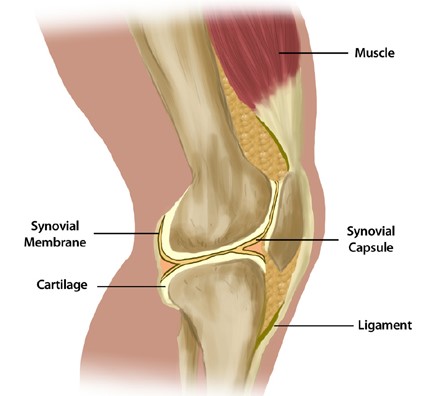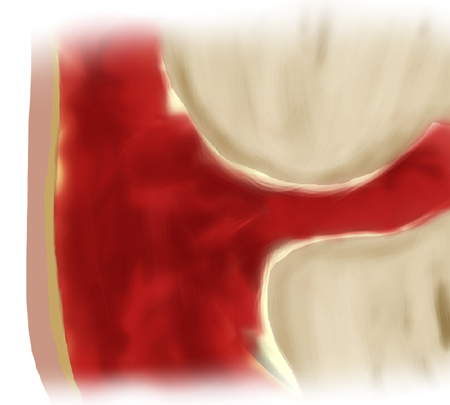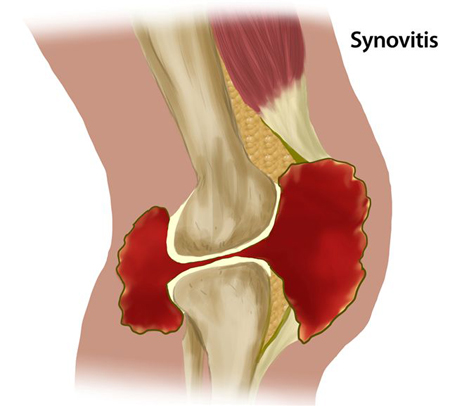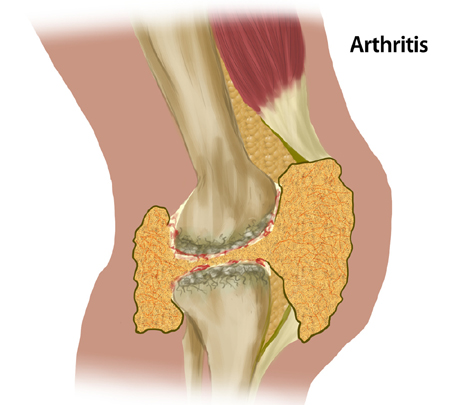Joint Damage
The most common place for a person with Hemophilia to bleed is the space inside their joints. Bleeding, particularly repeated bleeding, into joints or muscles can cause long-lasting problems. This section tells how these problems arise. Fortunately, with the treatments we have today, long-lasting disabilities or problems can often be prevented.
How joints are damaged by bleeding
A joint is the space where two bones meet. Together, the bones and joint bend and straighten body parts. For example, the knee is the joint that lets us bend and straighten our leg.
Certain kinds of joints are called synovial joints. A synovial joint is one that has a clear fluid inside of it called synovial fluid. This fluid makes the ends of the bones slide over each other smoothly. By keeping the bone ends from rubbing against each other, the synovial fluid protects the bones from wear and tear. It is like the way oil in a car's engine keeps the pistons running smoothly.
Our shoulders, elbows, wrists, hands, knees, ankles, and feet all have synovial joints. Our spine, ribs, skull, and pelvis do not. In a person with Hemophilia, the synovial joints are the ones damaged most often.
Blood flowing into the space in the synovial joint causes damage to the joint. If this happens often enough, it causes arthritis. This can cause mild to severe pain when the person uses the joint. To show how this happens, we will look at a normal knee joint and compare it to one that has bled over and over. This picture shows the inside of a normal knee joint. Find the parts of the joint in the picture as you read about them below.

- Joint cartilage - a smooth layer of body tissue which covers and protects the ends of the bones in a joint.
- Ligaments - strong bands of body tissue which connect and support two bones or pieces of cartilage. Ligaments keep a joint from moving too far out of line (dislocating).
- Synovial capsule - a tough, elastic casing which surrounds and protects the entire joint. The synovial membrane lines the inside of the synovial capsule.
- Synovial membrane - the membrane lining the inside of the joint capsule. It does not cover the cartilage at the end of the bones. The synovial membrane contains many small blood vessels and makes the synovial fluid.
- Muscle - body tissue that can contract and relax to move itself or other body tissue.
- Tendon - the tough band of tissue that attaches a muscle to a bone.
Muscles, tendons, and ligaments work together to support a joint and make it stronger. Weak joints will have more bleeding into the synovial capsule than strong ones. This is because weak joints do not have as much support or protection. Regular exercise will keep joints strong.
Bleeding in the joint starts from breaks in the tiny blood vessels of the synovial membrane. These breaks may be caused by an injury such as hitting your knee. In a person with severe Hemophilia, they may happen without a clear cause. Blood starts to leak into the synovial space.
Early signs of a joint bleed are a bubbling or tingling feeling, or a feeling of heat in the joint. The bleeding will usually stop if the person takes factor right away. The sooner the bleeding is stopped, the less damage that will be done to the joint.
This picture shows joint that has just started bleeding.

This picture shows a joint bleed that hasn't been treated.

Here the bleeding continues because the person did not take factor. It may stop when the joint space is filled up. By this point, the capsule has been stretched and the joint has become inflamed and irritated by the blood. It hurts a lot. Some signs that bleeding has being going on in a joint for a long time are swelling, heat, stiffness, and pain. Bending the knee may be the only position the person can bear. However, this position causes even more stiffness. If the joint stays in a bent (flexed) position too long, it will be hard to straighten.
A joint bleed that has gone this far still needs factor. Other medical care and physical therapy (PT) may also be needed to help with the pain and stiffness.
This picture shows a knee joint with synovitis and the beginning of arthritis.

Without factor, the bleeding continues indefinitely. The knee looks swollen and spongy. The blood inside the joint irritates and makes the synovial lining overgrow and get thick over time. The lining grows more blood vessels, which makes it likely to bleed again. A cycle begins that is hard to stop. Untreated bleeding leads to the growth of more blood vessels in the joint which leads to more bleeding. This problem with the synovial lining is called synovitis.
The joint may seem to get better after time, but the joint is damaged. Your body sends cells called macrophages into the synovial space to break down the blood. The synovial space becomes filled with iron, broken down blood, and scar tissue. As this happens, the space between the bones becomes smaller and smaller. The ends of the bones are less lubricated and protected. The synovial membrane gets thicker and thicker.
The macrophages that break down the blood in the joint don't stop there. They begin to attack and break down the smooth cartilage on the ends of the bones. The cartilage becomes ragged and pitted. The ends of the bones soften. It becomes very painful to move the joint. Ligaments and tendons that were stretched during bleeds now become slack from not being used.
Arthritis effect the entire knee joint in this picture.

The joint and bones are slowly destroyed. The cartilage continues to crumble. The unprotected ends of the bones begin to spread out. As the ends of the bones shift, they rub together. This causes intense pain when you move. Bending the knee becomes almost impossible since the joint contains so much scar tissue.
The joint is lost, resulting in a painful condition called degenerative arthritis. The knee becomes too stiff, making it painful to move. The muscles become weak from not being used. This makes them more likely to bleed.
It is a vicious cycle. When a joint bleed is not treated quickly or completely, the joints and bones are damaged. The muscles weaken, then more bleeding occurs, resulting in long-lasting damage. If this happens, physical therapy or surgery may help.
People with Hemophilia can avoid this painful cycle by:
- Learning to tell the first signs of a joint bleed.
- Taking factor or other medications to prevent bleeds, as directed by an HTC.
- Taking factor as soon as a bleed starts.
- Exercising to make the muscles that protect their joints stronger. A physical therapist can help plan an exercise program.
Research suggests that any bleeding into a joint causes damage. For this reason, it is recommended that all people with severe Hemophilia and some individuals with mild or moderate Hemophilia be given prophylactic treatment. This means they take factor or non-factor medications such as emicizumab, regularly to try to prevent bleeding.
